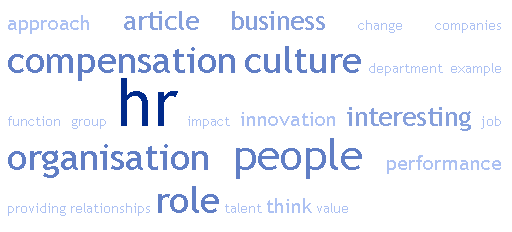Over at MiX, (here), Luc Galoppin posted an excellent blog that succinctly summarises some of the inherent problems and contradictions present in most HR departments. These can be summarised by HR’s ongoing desire for a seat at the top table and to be seen as a key driver of organisational strategy and change that have been top of the HR agenda since the publication of Dave Ulrich’s 1997 book Human Resource Champions (here).
One of Galoppin’s key assertions is that rather than an agent for change, which many HRD’s like to see themselves as (being able to design, implement and promote organisational change programs). HR is in fact naturally much better placed to act as a stabilising force within the business, as he states an agent of continuity during periods of change. Galoppin states:
“In short, HR does not posses the skills that are required to manage change initiatives. Instead, HR’s strength is that of a ‘Continuity Agent’, a stabilizer if you will.”
This makes sense when one considers HR’s traditional strengths such as developing systems and outlining processes and best practice. On the other hand, to be an active proponent and driver of change requires a much more disruptive and experimental approach, not natural attributes one would think of when describing most HR professionals.
The Ulrichian logic that the best way for HR to increase its influence is by being at the heart of decision-making and having greater influence over strategy and decision-making is according to Galoppin the wrong way for HR to think about its position within the business.
All is not lost however and Galoppin charts a three-step process that could help improve matters. By focusing on developing credibility and embedding HR within the business rather than an independent support function, things can change:
“The third step for HR is empowering the business by outsourcing the core part of their activities … to the business. Whereas step 1 may include the outsourcing of administrative tasks to a shared service center, this step will require a handover of activities to the business. That way, HR processes get managed where they live and exist: on the shop floor among the people.
Only by abdicating power and embedding HR practice directly within the business can HR prove its value. For many HR professionals still committed to the idea of a seat at the top table, this is unlikely to go down well. Many HRDs argue that to be influential they need to have control over all these people issues, when in actual fact the opposite is true. For HR to be seen to add real value to the organisation, the HR department needs to devolve as much control as possible.
It is however important to emphasise that the current predicament is not solely down to the inability of HR departments to demonstrate value. In many cases senior executives are guilty of failing to appreciate the complexity and importance of human behaviour, relationships and collaboration when it comes to organisational performance. As Galoppin puts it:
“The attitude in most projects is exemplified by this statement: "We’ll take care of the process re-engineering and the technical stuff; HR will do the soft stuff."”
The compartmentalising of the “soft stuff” is a very damaging attitude to have and highlights why many change projects are doomed to failure from the start. What many senior executives fail to appreciate is that it is actually the intangible people-side of things that is the hardest and most complex element of any change program that cannot be effectively sub-contracted to HR. In fact it can be argued that people-based issues represent the greatest risk to the success of any project. For this mindset to change, arguably it is going to require more than HR to prove its value, instead it will require senior executives to prioritise the naturally intangible, woolly and complex issues that surround the behavioural aspects of change.






